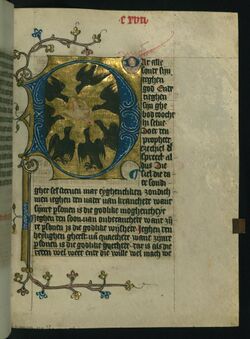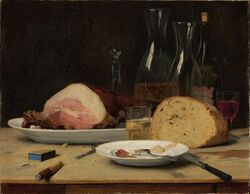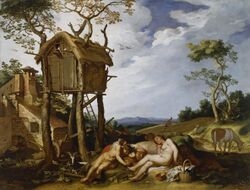Seven deadly sins
Topic: Religion
 From HandWiki - Reading time: 16 min
From HandWiki - Reading time: 16 min
| Part of a series on |
| Catholic philosophy |
|---|
   |
| Ethics |
| Schools |
| Philosophers |
The seven deadly sins, also known as the capital vices or cardinal sins, is a grouping and classification of vices within Christian, particularly Catholic, teachings.[1] According to the standard list, they are pride, greed, wrath, envy, lust, gluttony and sloth, which are contrary to the seven heavenly virtues.
This classification originated with Tertullian and continued with Evagrius Ponticus.[2]
The seven deadly sins are discussed in treatises and depicted in paintings and sculpture decorations on Catholic churches as well as older textbooks.[1]
History
Greco-Roman antecedents
Roman writers such as Horace extolled virtues, and they listed and warned against vices. His first epistles say that "to flee vice is the beginning of virtue and to have got rid of folly is the beginning of wisdom."[3]
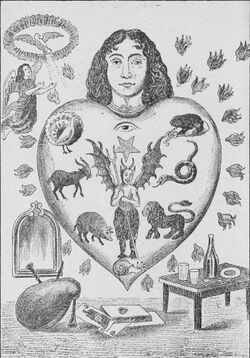
Origin of the currently recognized seven deadly sins
These "evil thoughts" can be categorized as follows:[4]
- physical (thoughts produced by the nutritive, sexual, and acquisitive appetites)
- emotional (thoughts produced by depressive, irascible, or dismissive moods)
- mental (thoughts produced by jealous/envious, boastful, or hubristic states of mind)
The fourth-century monk Evagrius Ponticus reduced the nine logismoi to eight, as follows:[5][6]
- Γαστριμαργία (gastrimargia) gluttony
- Πορνεία (porneia) prostitution, fornication
- Φιλαργυρία (philargyria) greed
- Λύπη (lypē) sadness, rendered in the Philokalia as envy, sadness at another's good fortune
- Ὀργή (orgē) wrath
- Ἀκηδία (akēdia) acedia, rendered in the Philokalia as dejection
- Κενοδοξία (kenodoxia) boasting
- Ὑπερηφανία (hyperēphania) pride, sometimes rendered as self-overestimation, arrogance, or grandiosity[7]
Evagrius's list was translated into the Latin of Western Christianity in many writings of John Cassian,[8][9] thus becoming part of the Western tradition's spiritual pietas or Catholic devotions as follows:[4]
- Gula (gluttony)
- Luxuria/Fornicatio (lust, fornication)
- Avaritia (greed)
- Tristitia (sorrow/despair/despondency)
- Ira (wrath)
- Acedia (sloth)
- Vanagloria (vain, glory)
- Superbia (pride, hubris)
In AD 590, Pope Gregory I revised the list to form a more common list.[10] Gregory combined tristitia with acedia and vanagloria with superbia, adding envy, which is invidia in Latin.[11][12] Thomas Aquinas uses and defends Gregory's list in his Summa Theologica, although he calls them the "capital sins" because they are the head and form of all the other sins.[13] Christian denominations, such as the Anglican Communion,[14] Lutheran Church,[15] and Methodist Church,[16] still retain this list, and modern evangelists such as Billy Graham have explicated the seven deadly sins.[17]
Historical and modern definitions, views, and associations
According to Catholic prelate Henry Edward Manning, the seven deadly sins are seven ways of eternal death.[18] The Lutheran divine Martin Chemnitz, who contributed to the development of Lutheran systematic theology, implored clergy to remind the faithful of the seven deadly sins.[19]
Listed in order of increasing severity as per Pope Gregory I, 6th-century A.D., the seven deadly sins are as follows:
Lust
Lust is generally thought to be the least serious capital sin.[20][21] Thomas Aquinas considers it an abuse of a faculty that humans share with animals and sins of the flesh are less grievous than spiritual sins.[22]
Gluttony
Gluttony (Latin: gula) is the overindulgence and overconsumption of anything to the point of waste. The word derives from the Latin gluttire, meaning to gulp down or swallow.[23] One reason for its condemnation is that the gorging of the prosperous may leave the needy hungry.[24]
Medieval church leaders such as Thomas Aquinas took a more expansive view of gluttony,[24] arguing that it could also include an obsessive anticipation of meals and overindulgence in delicacies and costly foods. Aquinas also listed five forms of gluttony:[25]
- Laute – eating too expensively
- Studiose – eating too daintily
- Nimis – eating too much
- Praepropere – eating too soon
- Ardenter – eating too eagerly
Greed

In the words of Henry Edward Manning, avarice "plunges a man deep into the mire of this world, so that he makes it to be his god".[18]
As defined outside Christian writings, greed is an inordinate desire to acquire or possess more than one needs, especially with respect to material wealth.[26] Aquinas considers that, like pride, it can lead to evil.[27]
Sloth
Sloth (Latin: tristitia, or acedia "without care") refers to a peculiar jumble of notions, dating from antiquity and including mental, spiritual, pathological, and physical states.[28] It may be defined as absence of interest or habitual disinclination to exertion.[29]
In his Summa Theologica, Saint Thomas Aquinas defined sloth as "sorrow about spiritual good".[27]
The scope of sloth is wide.[28] Spiritually, acedia first referred to an affliction attending religious persons, especially monks, wherein they became indifferent to their duties and obligations to God. Mentally, acedia has a number of distinctive components; the most important of these is affectlessness, a lack of any feeling about self or other, a mind-state that gives rise to boredom, rancor, apathy, and a passive inert or sluggish mentation. Physically, acedia is fundamentally associated with a cessation of motion and an indifference to work; it finds expression in laziness, idleness, and indolence.[28]
Sloth includes ceasing to utilize the seven gifts of grace given by the Holy Spirit (Wisdom, Understanding, Counsel, Knowledge, Piety, Fortitude, and Fear of the Lord); such disregard may lead to the slowing of spiritual progress towards eternal life, the neglect of manifold duties of charity towards the neighbor, and animosity towards those who love God.[18]
Unlike the other seven deadly sins, which are sins of committing immorality, sloth is a sin of omitting responsibilities. It may arise from any of the other capital vices; for example, a son may omit his duty to his father through anger. The state and habit of sloth is a mortal sin, while the habit of the soul tending towards the last mortal state of sloth is not mortal in and of itself except under certain circumstances.[18]
Emotionally, and cognitively, the evil of acedia finds expression in a lack of any feeling for the world, for the people in it, or for the self. Acedia takes form as an alienation of the sentient self first from the world and then from itself. The most profound versions of this condition are found in a withdrawal from all forms of participation in or care for others or oneself, but a lesser yet more noisome element was also noted by theologians. Gregory the Great asserted that, "from tristitia, there arise malice, rancour, cowardice, [and] despair". Chaucer also dealt with this attribute of acedia, counting the characteristics of the sin to include despair, somnolence, idleness, tardiness, negligence, laziness, and wrawnesse, the last variously translated as "anger" or better as "peevishness". For Chaucer, human's sin consists of languishing and holding back, refusing to undertake works of goodness because, he/she tells him/herself, the circumstances surrounding the establishment of good are too grievous and too difficult to suffer. Acedia in Chaucer's view is thus the enemy of every source and motive for work.[30]
Sloth subverts the livelihood of the body, taking no care for its day-to-day provisions, and slows down the mind, halting its attention to matters of great importance. Sloth hinders the man in his righteous undertakings and thus becomes a terrible source of human's undoing.[30]
Wrath
Wrath (ira) can be defined as uncontrolled feelings of anger, rage, and even hatred. Wrath often reveals itself in the wish to seek vengeance.[31]
According to the Catechism of the Catholic Church, the neutral act of anger becomes the sin of wrath when it is directed against an innocent person, when it is unduly strong or long-lasting, or when it desires excessive punishment. "If anger reaches the point of a deliberate desire to kill or seriously wound a neighbor, it is gravely against charity; it is a mortal sin." (CCC 2302) Hatred is the sin of desiring that someone else may suffer misfortune or evil and is a mortal sin when one desires grave harm (CCC 2302–03).[32]
People feel angry when they sense that they or someone they care about has been offended, when they are certain about the nature and cause of the angering event, when they are certain someone else is responsible, and when they feel that they can still influence the situation or cope with it.[33]
Henry Edward Manning considers that "angry people are slaves to themselves".[18]
Envy
According to St. Thomas Aquinas, the struggle aroused by envy has three stages: during the first stage, the envious person attempts to lower another's reputation; in the middle stage, the envious person receives either "joy at another's misfortune" (if he succeeds in defaming the other person) or "grief at another's prosperity" (if he fails); and the third stage is hatred because "sorrow causes hatred".[34]
Bertrand Russell said that envy was one of the most potent causes of unhappiness, bringing sorrow to committers of envy, while giving them the urge to inflict pain upon others.[35]
Pride
Pride (superbia), also known as hubris (from Ancient Greek ὕβρις) or futility. It is considered the original and worst of the seven deadly sins on almost every list, the most demonic.[36] It is also thought to be the source of the other capital sins. Pride is the opposite of humility.[37][38]
Pride has been labeled the mother of all sins and has been deemed the devil's most essential trait. C.S. Lewis writes in Mere Christianity that pride is the "anti-God" state, the position in which the ego and the self are directly opposed to God: "Unchastity, anger, greed, drunkenness and all that, are mere fleabites in comparison: it was through Pride that the devil became the devil: Pride leads to every other vice: it is the complete anti-God state of mind."[39] Pride is understood to sever the spirit from God, as well as His life-and-grace-giving Presence.[18]
One can be prideful for different reasons. Author Ichabod Spencer states that "spiritual pride is the worst kind of pride, if not worst snare of the devil. The heart is particularly deceitful on this one thing."[40] Jonathan Edwards said: "remember that pride is the worst viper that is in the heart, the greatest disturber of the soul's peace and sweet communion with Christ; it was the first sin that ever was and lies lowest in the foundation of Satan's whole building and is the most difficultly rooted out and is the most hidden, secret and deceitful of all lusts and often creeps in, insensibly, into the midst of religion and sometimes under the disguise of humility."[41]
The modern use of pride may be summed up in the biblical proverb, "Pride goeth before destruction, a haughty spirit before a fall" (abbreviated "Pride goeth before a fall", Proverbs 16:18). The "pride that blinds" causes foolish actions against common sense.[42] In political analysis, "hubris" is often used to describe how leaders with great power over many years become more and more irrationally self-confident and contemptuous of advice, leading them to act impulsively.[42]
Throughout history, artists have found inspiration in the timeless themes of morality and human nature, and the seven deadly sins have been a particularly fertile subject for exploration. These sins, traditionally categorized as pride, envy, wrath, sloth, avarice, gluttony, and lust, have been depicted in a variety of ways, from allegorical representations to satirical observations of human behavior.
One of the most notable artists to tackle this subject was Pieter Bruegel the Elder, a Flemish painter of the Renaissance. His 1557 series of woodcuts, known as the "Seven Deadly Sins," vividly captures the essence of each sin through a series of grotesque and comical scenes. In "Sloth," a group of slovenly individuals sleep soundly, oblivious to the world around them. "Avarice" depicts a miser counting his coins with a miserly expression, while "Gluttony" shows a gluttonous man consuming an enormous meal, oblivious to his surroundings.
Other notable artists who have explored the seven deadly sins include:
- Lucas Cranach the Elder: German painter of the Renaissance, known for his religious paintings and sensual portraits. His portrayals of Adam and Eve often emphasize their nakedness and vulnerability, reflecting the concept of lust.
- Peter Paul Rubens: Flemish painter of the Baroque period, known for his dynamic compositions and vibrant colors. His painting "The Wrath of Achilles" depicts the Greek hero in a rage, his face contorted in anger as he prepares to slay a Trojan prisoner.
- William Hogarth: English painter and printmaker of the 18th century, known for his satirical social commentary. His series of paintings "Marriage A-la-Mode" satirizes the follies and vices of the upper classes, with each panel depicting a different stage of a marriage that eventually ends in ruin.
- Paul Cadmus: American painter of the 20th century, known for his social realist paintings. His series of paintings "The Seven Deadly Sins" depicts the sins in a more contemporary setting, using exaggerated figures and satirical humor to critique modern society.
- Chris Ofili: British painter of the 21st century, known for his use of unconventional materials such as elephant dung and glitter. His series of paintings "The Seven Deadly Sins" utilizes these materials to create a visually striking and often disturbing depiction of the sins.
- Yves Decadt: a Flemish artist, has created a series of artworks titled “Falling Angels: Allegories about the 7 Sins and 7 Virtues for Falling Angels and other Curious Minds”. The series explores the topic of morality, sins, and virtues, which have dominated Western cultures for more than 2000 years. In this work, Decadt follows in the footsteps of Pieter Breughel, who made a series of sketches on the 7 sins and 7 virtues about 500 years ago. The work takes the viewer on an adventurous trip through time and across the barriers and edges of reality, mythology, religion, and culture.
Historical sins
Acedia
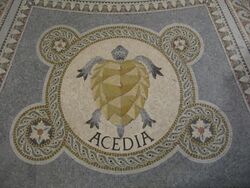
Acedia (Latin, acedia "without care";[28] from Greek ἀκηδία) is the neglect to take care of something that one should do. It is translated to apathetic listlessness; depression without joy. It is related to melancholy; acedia describes the behaviour and melancholy suggests the emotion producing it. In early Christian thought, the lack of joy was regarded as a willful refusal to enjoy the goodness of God. By contrast, apathy was considered a refusal to help others in times of need.
Acēdia is the negative form of the Greek term κηδεία (Kēdeia), which has a more restricted usage. 'Kēdeia' refers specifically to spousal love and respect for the dead.[43]
Pope Gregory combined this with tristitia into sloth for his list. When Thomas Aquinas described acedia in his interpretation of the list, he described it as an "uneasiness of the mind", being a progenitor for lesser sins such as restlessness and instability.[44]
Acedia is currently defined in the Catechism of the Catholic Church as spiritual sloth, believing spiritual tasks to be too difficult.[45] In the fourth century, Christian monks believed that acedia was primarily caused by a state of melancholia that caused spiritual detachment instead of laziness.[46]
Vainglory
Vainglory (Latin, vanagloria) is unjustified boasting. Pope Gregory viewed it as a form of pride, so he folded vainglory into pride for his listing of sins.[11] According to Aquinas, it is the progenitor of envy.[47]
The Latin term gloria roughly means boasting, although its English cognate glory has come to have an exclusively positive meaning. Historically, the term vain roughly meant futile (a meaning retained in the modern expression "in vain"), but by the fourteenth century had come to have the strong narcissistic undertones which it still retains today.[48]
Confession patterns
According to a 2009 study by the Jesuit scholar Fr. Roberto Busa, the most common deadly sin confessed by men is lust and the most common deadly sin confessed by women is pride.[49] It was unclear whether these differences were due to the actual number of transgressions committed by each sex or whether differing views on what "counts" or should be confessed caused the observed pattern.[50]
See also
References
- ↑ 1.0 1.1 Tucker, Shawn (2015). The Virtues and Vices in the Arts: A Sourcebook. Cascade. ISBN 978-1625647184.
- ↑ "The Seven Deadly Sins". https://www.catholic.com/magazine/print-edition/the-seven-deadly-sins.
- ↑ Tilby, Angela (23 April 2013). The Seven Deadly Sins: Their origin in the spiritual teaching of Evagrius the Hermit. SPCK. ISBN 9780281062997. https://books.google.com/books?id=O3WpAwAAQBAJ.
- ↑ 4.0 4.1 Refoule, F. (1967) "Evagrius Ponticus," In New Catholic Encyclopaedia, Vol. 5, pp. 644f, Staff of Catholic University of America, Eds., New York: McGraw-Hill.
- ↑ Evagrio Pontico, Gli Otto Spiriti Malvagi, trans., Felice Comello, Pratiche Editrice, Parma, 1990, p.11-12.
- ↑ Evagrius (22 June 2006). The Greek Ascetic Corpus. Oxford and New York: Oxford University Press. ISBN 0199297088.
- ↑ In the translation of the Philokalia by Palmer, Ware and Sherrard.
- ↑ "NPNF-211. Sulpitius Severus, Vincent of Lerins, John Cassian – Christian Classics Ethereal Library". http://www.ccel.org/ccel/schaff/npnf211.iv.iii.html.
- ↑ Cassian, John (3 January 2000). The Institutes (First ed.). New York: Newman Press of the Paulist Press. ISBN 9780809105229.
- ↑ "For pride is the root of all evil, of which it is said, as Scripture bears witness; Pride is the beginning of all sin. [Ecclus. 10, 1] But seven principal vices, as its first progeny, spring doubtless from this poisonous root, namely, vain glory, envy, anger, melancholy, avarice, gluttony, lust." Gregory the Great, Moralia in Iob, book XXXI
- ↑ 11.0 11.1 DelCogliano, Mark (18 November 2014). Gregory the Great: Moral Reflections on the Book of Job, Volume 1. Cistercian Publications. ISBN 9780879071493.
- ↑ Tucker, Shawn R. (24 February 2015). The Virtues and Vices in the Arts: A Sourcebook. Cascade Books, an Imprint of Wipf and Stock Publishers.
- ↑ "SUMMA THEOLOGICA: The cause of sin, in respect of one sin being the cause of another Prima Secundae Partis, Q. 84; I-II,84,3)". http://www.newadvent.org/summa/2084.htm#article4.
- ↑ Armentrout, Don S. (1 January 2000) (in en). An Episcopal Dictionary of the Church: A User-Friendly Reference for Episcopalians. Church Publishing, Inc.. p. 479. ISBN 9780898697018.
- ↑ Lessing, Reed (25 August 2002). "Mighty Menacin' Midianites" (in en). The Lutheran Hour. http://www.lutheranhour.org/sermon.asp?articleid=648&mode=print.
- ↑ Speidel, Royal. "What Would a United Methodist Jesus Do?" (in en). UCM. https://ucmpage.org/articles/rspeidel.htm. "Thirdly, the United Methodist Jesus reminds us to confess our sins. How long has it been since you have heard reference to the seven deadly sins: pride, gluttony, sloth, lust, greed, envy and anger?"
- ↑ (in en) The American Lutheran, Volumes 39–40. American Lutheran Publicity Bureau. 1956. p. 332. https://books.google.com/books?id=KaHmAAAAMAAJ. "The world-renowned Evangelist, Billy Graham, presents in this volume an excellent analysis of the seven deadly sins which he enumerates as pride, anger, envy, impurity, gluttony, avarice and slothfulness."
- ↑ 18.0 18.1 18.2 18.3 18.4 18.5 Manning, Henry Edward. Sin and Its consequences.
- ↑ Martin Chemnitz (2007) (in en). Ministry, Word, and Sacraments: An Enchiridion; The Lord's Supper; The Lord's Prayer. Concordia Publishing House. ISBN 978-0-7586-1544-2.
- ↑ Dorothy L. Sayers, Purgatory, Introduction, pp. 65–67 (Penguin, 1955).
- ↑ Pyle, Eric (31 December 2014) (in en). William Blake's Illustrations for Dante's Divine Comedy: A Study of the Engravings, Pencil Sketches and Watercolors. McFarland. ISBN 9781476617022. https://books.google.com/books?id=uf62BQAAQBAJ.
- ↑ Aquinas, St Thomas (1 January 2013) (in en). Summa Theologica, Volume 4 (Part III, First Section). Cosimo. ISBN 9781602065604. https://books.google.com/books?id=VeP7kg-blnIC&q=lust%2520summa%2520theologica&pg=PA1819.
- ↑ "Latin Definition for: gluttio, gluttire, -, – (ID: 21567) – Latin Dictionary and Grammar Resources – Latdict". https://latin-dictionary.net/definition/21567/gluttio-gluttire.
- ↑ 24.0 24.1 Okholm, Dennis. "Rx for Gluttony". Christianity Today, Vol. 44, No. 10, 11 September 2000, p.62
- ↑ "Gluttony". Catholic Encyclopedia. http://www.newadvent.org/cathen/06590a.htm.
- ↑ "greed". greed (5th ed.). Houghton Mifflin Harcourt. 2016. http://www.thefreedictionary.com/greed. Retrieved 4 February 2019.
- ↑ 27.0 27.1 Aquinas, Thomas (20 August 2013) (in en). Summa Theologica (All Complete & Unabridged 3 Parts + Supplement & Appendix + interactive links and annotations). e-artnow. ISBN 9788074842924. https://books.google.com/books?id=YiJCBAAAQBAJ.
- ↑ 28.0 28.1 28.2 28.3 Lyman, Stanford (1989). The Seven Deadly Sins: Society and Evil. Rowman & Littlefield. pp. 5. ISBN 0-930390-81-4.
- ↑ "the definition of sloth". http://www.dictionary.com/browse/sloth?s=t.
- ↑ 30.0 30.1 Lyman, Stanford. The Seven Deadly Sins: Society and Evil. pp. 6–7.
- ↑ Landau, Ronnie (30 October 2010). The Seven deadly Sins: A companion. Lulu.com. ISBN 978-1-4457-3227-5.
- ↑ "CCC, 2302-3". Vatican.va. http://www.vatican.va/archive/ccc_css/archive/catechism/p3s2c2a5.htm.
- ↑ International Handbook of Anger. p. 290
- ↑ "Summa Theologica: Treatise on The Theological Virtues (QQ[1] – 46): Question. 36 – Of Envy (four articles)". Sacred-texts.com. http://www.sacred-texts.com/chr/aquinas/summa/sum291.htm.
- ↑ Russell, Bertrand (1930). The Conquest of Happiness. New York City: H. Liverwright. p. 86. https://archive.org/details/conquestofhappin0000russ.
- ↑ Climacus, John. The Ladder of Divine Ascent, Translation by Colm Luibheid and Norman Russell. pp. 62–63.
- ↑ "Humility vs Pride And Why The Difference Should Matter To You | Jeremie Kubicek" (in en-US). https://jeremiekubicek.com/humility-vs-pride/.
- ↑ Acquaviva, Gary J. (2000) (in en). Values, Violence and Our Future. Rodopi. ISBN 9042005599. https://books.google.com/books?id=qAtNAPteVk0C&q=Pride+is+generally+associated+with+an+absence+of+humility&pg=PA31.
- ↑ Mere Christianity, C.S. Lewis, ISBN:978-0-06-065292-0
- ↑ Dictionary of Burning Words of Brilliant Writers. 1895. pp. 485.
- ↑ Claghorn, George. To Deborah Hatheway, Letters and Personal Writings (Works of Jonathan Edwards Online Vol. 16).
- ↑ 42.0 42.1 Hollow, Matthew (2014). "The 1920 Farrow's Bank Failure: A Case of Managerial Hubris". Journal of Management History (Durham University) 20 (2): 164–178. doi:10.1108/JMH-11-2012-0071. https://www.academia.edu/6081830. Retrieved 1 October 2014.
- ↑ Henry George Liddell and Robert Scott. A Greek-English Lexicon. Revised by Sir Henry Stuart Jones and Roderick McKenzie. Oxford: Clarendon Press, 1940.
- ↑ McCarron, Bill; Knoke, Paul (2002), "From Gent to Gentil: Jed Tewksbury and the Function of Literary Allusion in A Place to Come To", Robert Penn Warren Studies 2 (1), https://digitalcommons.wku.edu/rpwstudies/vol2/iss1/6/
- ↑ "CCC, 2733". Vatican.va. http://www.vatican.va/archive/ccc_css/archive/catechism/p4s1c3a2.htm.
- ↑ "Before Sloth Meant Laziness, It Was the Spiritual Sin of Acedia" (in en). Atlas Obscura. 14 July 2017. https://www.atlasobscura.com/articles/desert-fathers-sins-acedia-sloth.
- ↑ Cite error: Invalid
<ref>tag; no text was provided for refs namedbooks.google.com - ↑ Oxford English dictionary
- ↑ "Two sexes 'sin in different ways'". BBC News. 18 February 2009. http://news.bbc.co.uk/2/hi/7897034.stm.
- ↑ Morning Edition (20 February 2009). "True Confessions: Men And Women Sin Differently". NPR. https://www.npr.org/templates/story/story.php?storyId=100906920.
Further reading
- Cassian, John (1885). "The Remedies for the Eight Principal Faults.". Ante-Nicene Christian Library, Volume XI. T. & T. Clark in Edinburgh.
- de la Puente, Lius (1852). "On Pride and Vainglory". Meditations On The Mysteries Of Our Holy Faith. Richarson and Son.
- Schumacher, Meinolf (de) (2005): "Catalogues of Demons as Catalogues of Vices in Medieval German Literature: 'Des Teufels Netz' and the Alexander Romance by Ulrich von Etzenbach." In In the Garden of Evil: The Vices and Culture in the Middle Ages. Edited by Richard Newhauser, pp. 277–290. Toronto: Pontifical Institute of Mediaeval Studies.
- The Concept of Sin, by Josef Pieper
- The Traveller's Guide to Hell, by Michael Pauls & Dana Facaros
- Sacred Origins of Profound Things, by Charles Panati
- The Faerie Queene, by Edmund Spenser
- The Seven Deadly Sins Series, Oxford University Press (7 vols.)
- Rebecca Konyndyk DeYoung, Glittering Vices: A New Look at the Seven Deadly Sins and Their Remedies, (Grand Rapids: BrazosPress, 2009)
- Solomon Schimmel, The Seven Deadly Sins: Jewish, Christian and Classical Reflections on Human Psychology, (New York: Oxford University Press, 1997)
- Slater S.J., Thomas (1925). "Book 4: On Sin (Pride)". A manual of moral theology for English-speaking countries. Burns Oates & Washbourne Ltd..
- Tucker, Shawn. The Virtues and Vices in the Arts: A Sourcebook, (Eugene, OR: Cascade Press, 2015)
External links
 |
 KSF
KSF
